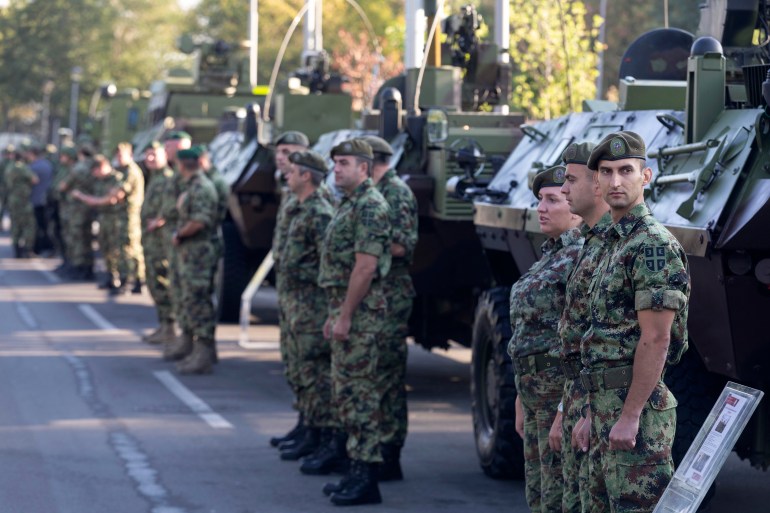Mersiha Gadzo

In 2019, Serbia made headlines by overtaking NATO member Croatia as the Balkan region’s biggest military spender, spending $1.14bn, an increase of 43 percent from the previous year.
This year, Serbia’s defence budget almost doubled from the 2018 figure of $700m to about $1.5bn, according to open-source intelligence specialists at Janes Defence Budgets.
As the pandemic intensified last year, many Serbians questioned the country’s priorities when it was reported in November that more money was being spent on weapons than setting up COVID-19 hospitals.
Meanwhile, displays of military power have become regular.
In September, as Serb unity was celebrated as part of a new national holiday, President Aleksandar Vucic said the army was “five times stronger” than a few years ago, as he announced greater expenditure.
Following a June military drill in the Sandzak region, Vucic said that the army will be “drastically increased in the next nine months”, and will “always be in a position to defend our country and people”.
The announcements have made some in neighbouring countries such as Bosnia and Herzegovina, Kosovo and Montenegro wary about Serbia’s motives, especially amid calls by Interior Minister Aleksandar Vulin on forming a “Serb World”.
Vulin has repeatedly said in public and to local media that all Serbs need to unite politically under the direction of Belgrade, and “with time, to peacefully … unite formally”, suggesting they unite the territories where they live.
Critics have slammed his calls as an updated version of the Greater Serbia ideology of the 1990s, which culminated in war and ethnic cleansing in the region.
“The Serb World is indistinguishable from Greater Serbia, or all Serbs in one country,” said Daniel Serwer, one of the negotiators of the 1995 Dayton Peace Agreement which ended the war in Bosnia.
Reuf Bajrovic, co-chair of the US-Europe Alliance organisation, told Al Jazeera that he believes Vucic is preparing to use military force in Kosovo and Bosnia when international circumstances change in his favour – such as when US troops withdraw from KFOR (the NATO-led peacekeeping force in Kosovo) or when Russia – Serbia’s ally – decides to directly intervene in the region.
“Russia-trained mercenaries in Bosnia and Montenegro are an integral part of the Serbian military strategy for the region. It is a carbon copy of [Russian President Vladimir] Putin’s pre-invasion actions in Georgia and Ukraine,” Bajrovic said.
“Vucic government officials have openly stated that Serbia will use military force in its neighbourhood, including a threat Vucic issued against NATO troops in Kosovo last week,” Bajrovic said.
Last week, as tensions escalated at the Serbia-Kosovo border due to a dispute over licence plates, Vucic gave NATO an ultimatum of 24 hours to react in case violence broke out against Kosovo Serbs.
If they failed to do so, Serbia would “react”, he told the NATO secretary general in a phone call.
“We have 14 MiG-29s now,” Vucic recounted telling Western officials on a Serbian talk show. “They thought I was joking … Does Serbia not have the right to [use] its helicopters and planes in central Serbia?”
Serbia would have to abandon any EU ambitions if it acted militarily against Bosnia or Kosovo, said Serwer, adding, “But Vucic appears to have already given up on EU accession.
“The situation is dangerous. NATO needs to make clear that it will not tolerate Serbian mobilisation of forces against its neighbours, as it did last week against Kosovo, which has no army.”
According to Janes Defence Budgets, “tensions with the former Serbian province of Kosovo remain the single most important determinant of national security” for Serbia.
‘Hidden from the public eye’
Where exactly Serbian defence policy is heading is a “million-dollar question” for Marija Ignjatijevic, researcher at the Belgrade Centre for Security Policy.
“Most of [Serbia’s] planning and strategic documents remain hidden from the public eye or are non-existent,” she said, explaining that military budget increases are made “ad hoc” in accordance with foreign policy interests.
“Moreover, the Serbian Armed Forces and armament are constantly misused in pompous nationally broadcast exercises and parades, followed by tabloid outlet campaigns – in order to consolidate power and gain more votes, but also to score in geostrategic games,” Ignjatijevic said.
Andrew MacDonald, lead analyst at Janes Defence Budgets, told Al Jazeera that in 2021, Serbia’s defence spending jumped to 2.6 percent of its GDP, “definitely outside of the country’s norm” and “above average, especially for Europe”.
For Serwer, Vucic’s stance is “clear”.
While it is doubtful that the Serbian president will use military force in Kosovo or Bosnia soon, “he would welcome an opportunity to do so,” Serwer said.
“Serbia is beefing up its ties to Russia and China, reducing its European aspirations, and focusing on the ‘Serb World,’ which is another name for Greater Serbia.
“The military balance in the region is shifting, which has an impact on perceptions everywhere.”
No comments:
Post a Comment